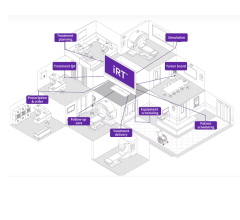
A strong sense of purpose and high level of confidence encompasses the mindset of the American Society of Radiologic Technologists’ (ASRT) government relations department. This attitude has been especially important this year as the department has been extremely busy providing legislative counsel to states pursuing radiologic technology licensure and working the halls of Congress to push for reimbursement for radiologist assistant (RA) services. It also continues to seek basic minimum education standards for radiologic technologists who perform services for patients within the Medicare framework.
As ASRT’s legislative arm, the government relations department has to monitor legislation in every state, closely follow regulatory changes and maintain contact with congressional representatives on Capitol Hill. As a result, the department has increased its efforts in every area this year so it can stay abreast of the rapidly changing regulatory landscape.
Establishing State Standards
Focusing on state legislative efforts this year is a paradigm shift for ASRT, but it’s a strategic approach that should pay dividends over time. As recent history shows, moving legislation through Congress has become increasingly difficult, so working with state legislatures is the next logical step. It is incredibly important, as Alabama, Idaho, Missouri, South Dakota, North Carolina and Washington, D.C., have absolutely no licensure requirements on the books for the personnel who perform medical imaging and radiation therapy procedures. Even more, many other states have bare-bones standards in place, allowing personnel to administer ionizing radiation after completing minimal training.
According to ASRT Vice President of Government Relations and Public Policy Christine Lung, establishing standards in every state is a solid investment for the profession and patient care. “Individuals who perform medical imaging and radiation therapy procedures use some of the most cutting-edge equipment in healthcare, and the majority of the equipment administers ionizing radiation, which can be highly dangerous if managed improperly. Putting basic measures in place that require individuals to learn radiation safety, best practices in patient shielding and proper positioning is just common sense.”
At the state level, the Missouri Society of Radiologic Technologists and the North Carolina Society of Radiologic Technologists are working with their legislatures on licensure bills. In addition, Michigan, a state with minimal standards, has a bill in play that sets performance standards for the personnel who operate medical imaging and radiation therapy equipment. What’s great is the state affiliates are taking serious steps to promote the pieces of legislation. The Michigan, North Carolina and Missouri affiliates have all hosted advocacy days in their respective state capitols this year. Hundreds of technologists have visited with lawmakers to educate them about the need for strong licensure standards. In the second half of the year, the government relations team is going to work with several non-licensure states to spearhead legislative efforts in 2015.
In addition to managing legislative initiatives, ASRT also has to combat threats to patient safety and professional practice. For example, earlier this year the Sunset Advisory Commission of the Texas Legislature recommended eliminating licensure requirements for 19 occupations, including radiologic technologists and medical physicists. In response, ASRT rallied a number of national radiologic science organizations to travel to the state capitol in Austin to urge the commission to maintain licensing standards for radiologic technologists in Texas. Because of these efforts, a subcommittee of the Commission recommended that the state move its medical radiologic technologists and medical physicists licensure programs from the Department of State Health and Services to the Texas Medical Board, effectively preserving R.T. licensure in Texas.
Establishing Federal Standards
On the federal level, ASRT has focused on garnering support for the Medicare Access to Radiology Care Act (MARCA) legislation, HR 1148. MARCA would allow facilities to bill Medicare for medical imaging services performed by qualified radiologist assistants under the direction of a supervising radiologist. The legislation is vital to patient care as it sets standards within the Medicare program for services provided by radiology physician extenders, reduces existing RA supervision restrictions and allows facilities to be reimbursed for the services RAs perform at 85 percent of the existing physician fee schedule rate.
“Medical imaging departments are extremely busy, and RAs provide them with an opportunity to increase services and provide exemplary care,” said Lung. “By ensuring that facilities get reimbursed for services performed by qualified radiologist extenders, we’re taking another step toward enhancing patient care, raising the profile of the profession and giving technologists an opportunity to learn more and become greater assets to the medical imaging team.”
In addition to MARCA, ASRT and its team in Washington, D.C., have been working on the Consistency, Accuracy, Responsibility and Excellence (CARE) in Medical Imaging and Radiation Therapy bill, HR 1146 and S. 692. CARE would set federal education and certification standards in the Medicare program for the technical personnel providing, planning and delivering all medical imaging examinations and radiation therapy treatments. ASRT has focused on this legislation for a number of years, but this year the society is working other avenues to enact CARE’s parameters. Rather than simply focus on securing cosponsors for the bill, ASRT is seeking to have it attached to other legislation as amendatory language. By widening the approach, there is a better chance of seeing minimum education and certification standards actually become a reality at the federal level.
Radiation Safety Measures and Protocols
In addition to the state and federal legislative efforts, the government relations team is working with other medical imaging and radiation therapy organizations to shore up radiation safety measures and protocols. ASRT also is on call to provide expert opinion and guidance for the U.S. Food and Drug Administration (FDA) and the Centers for Medicare & Medicaid Services (CMS) patient safety measures in relation to radiologic procedures.
“ASRT has become a go-to source at the federal level for committees, task forces and other entities looking to learn about medical imaging and radiation therapy and safety protocols,” said Lung. “Our members have clout in Washington, D.C., so it’s nice to know that these agencies look to us for guidance and information.”
This year has turned out to be incredibly busy on the legislative and advocacy front, and there is really no end in sight. The legislative arena is very fluid and things change quickly. However, the ASRT government relations team continuously monitors the political landscape and forecasts strategies to address issues as they surface. By staying ahead of the game, the team is able to protect the profession, build on its relationships with legislative stakeholders and ultimately enact stronger patient safety measures. itn
Jake Buehler is director of public relations at ASRT.


 December 04, 2025
December 04, 2025 









